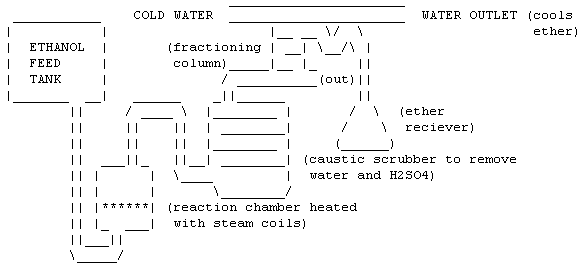

User Controls
Dextroamphetamine from Ethylene and Propionaldehyde
-
2017-03-30 at 9:33 AM UTCEthylene/Propionaldehyde > Propionic acid > propionyl chloride > Propiophenone > phenylpropanolamine > 1-phenyl-2-(phenylisopropyl)aminopropane > Amphetamine
Propionic Acid
https://en.m.wikipedia.org/wiki/Propionic_acidIn industry, propionic acid is mainly produced by the hydrocarboxylation of ethylene using nickel carbonyl as the catalyst:
H2C=CH2 + H2O + CO → CH3CH2CO2H
It is also produced by the aerobic oxidation of propionaldehyde. In the presence of cobalt or manganese ions, this reaction proceeds rapidly at temperatures as mild as 40–50 °C
Proprionyl Chloride
http://www.prepchem.com/synthesis-of-propionyl-chloride/
Propiophenone
PhenylpropanolamineOne method of currently manufacturing phenylpropanolamine is the reaction of propiophenone with an alkyl nitrite followed by catalytic reduction (hydrogenation) of the isonitrosopropiophenone intermediate. The main advantage of this process is that it produces essentially 100% of the desired dl-norephedrine stereoisomer. Such process, however, has significant disadvantages. It is a multi-step process with only moderate yields at each step resulting in relatively low overall yields. In addition, the manufacturing process generates large quantities of hazardous waste, disposal of which is expensive.
AmphetamineUsing the process of the invention, dextroamphetamine (S-(+)-amphetamine) can be stereospecifically prepared from a phenylpropanolamine having the S configuration at the carbon bearing the amino group, e.g., 1R,2S-(-)-norephedrine or 1S,2S-(+)-norpseudoephedrine (the erythro form of phenylpropanolamine is norephedrine and the threo form is norpseudoephedrine). In the process of the invention, the otherwise higher cost of the appropriate phenylpropanolamine diastereomers useful for preparing dextroamphetamine is offset by the shorter cycle times, a less labor-intensive process, and better chemical hygiene
Can also be used for methFor a direct route to dextroamphetamine, both b 1R,2S-(-)-norephedrine and 1S,2S-(+)-norpseudoephedrine have the correct steric configuration at the carbon bearing the amino group necessary to produce d-amphetamine [S-(+)-amphetamine] as shown in Scheme 3. 1R,2S-(-)-norephedrine is generally commercially available. This same process produces d-methamphetamine starting with either 1R,2S-(-)-ephedrine or 1S,2S-(+)-pseudoephedrine.
The following users say it would be alright if the author of this post didn't die in a fire! -
2017-03-30 at 9:49 AM UTCI'll kill you
-
2017-03-30 at 9:52 AM UTCPretty sure the phenylpropanolamine phase will do him in. If I know sc he wouldn't be able to resist trying to huff the hazardous byproducts.
-
2017-03-30 at 9:57 AM UTC
-
2017-03-31 at 6:06 AM UTCWhat is your reason for your proposal of propionic acid synthesis?
Id say this is far more thorough:
"All vessels used in this experiment must be absolutely DRY. 12 g of dry bright magnesium turnings are dissolved in a solution of 28 g of dry ethyl iodide in 20 ml of dry ether contained in a flask fitted with a reflux condenser. The action may, if necessary, be started by adding a crystal (0.05 g) of iodine; should it become too vigorous, it is moderated by cooling in water. When all the magnesium has dissolved, a not too rapid stream of carbon dioxide, washed once with sodium carbonate solution, twice with conc. sulphuric acid, and passed then over phosphorus pentoxide, is led in until it ceases to be absorbed, the flask being cooled if required. The ether is removed on a water bath and the residue distilled with dilute sulphuric acid (water is added as required) until the distillate is no longer acid. The propionic acid may be isolated by forming the lead salt, or the aqueous solution may be treated with excess of sodium carbonate and evaporated to dryness. The powdered residue is then distilled with conc. sulphuric acid until the temperature reaches 155° C. The distillate is again distilled, the fraction 137-142° C being retained. The yield of propionic acid 50% theoretical (7 g). Colourless liquid; rancid acid odour; m.p. 24° C ; b.p. 141° C;" -
2017-03-31 at 9:27 AM UTCThats dope ill have to try it.
-
2017-04-01 at 12:06 AM UTCHere is a bit about ether.
"Preparation 1
by Zaphraud
The reaction is conducted as follows:
Dry (anhydrous) or nearly dry ethyl alcohol is allowed to flow into a mixture of alcohol and sulfuric acid heated to 130°c-140°c. The vapors are collected, and ether and some alcohol and water condense out. The sulfuric acid is a catalyst, but since it becomes more and more dilluted as a consequence of the water produced by the reaction, the process becomes inefficient (which is why anhydrous ethanol is the best!)
The temperature of the reaction should be controlled carefully. At temperatures below 130°c, the reaction is too slow and mostly ethanol will distill. Over 150°c, the ethyl sulfuric acid decomposes, forming ethylene instead of combining with ethanol to form ether.
95% ethanol may be recovered from water + CH3CH2OH pulled from the bottom of the fractioning column (marked 'out')... by connecting it to another column and distilling it...
This may be converted to 100% ethanol by mixing the 95% with calcium oxide and distilling - the water is used up to make Calcium hydroxide! This in turn can be re-fed to the "FEED TANK" after cooling."
"Anhydrous Ethyl Ether. This is for those formulas calling for dry, pure, or anhydrous ether. The ether product from above is dried over thin slices of metallic sodium (metallic sodium wire works well also) for 24 hours. Then the ether is distilled on a water bath, over fresh (fresh means a different batch than what you used to dry with) metallic sodium. Note: Ether develops explosive peroxides upon sitting for any length of time, even if just purchased from a supply house. Therefore, before handling ether, which has been stored, shake with ferrous sulphate or with lead peroxide. To keep peroxides from forming in fresh ether; add several sections of copper or iron wire to the dark container and store in a cool place."
You probably already know about this though. -
2017-04-01 at 1:24 AM UTCSeems like a lot of work when ether is so easy to buy
-
2017-04-01 at 2:22 AM UTCYeah depending ob where you live this is true. But also being able to sustain your own production allows you all the profit and none of the fuckery.
-
2017-04-01 at 3 PM UTCWE almost have the schematics here for an industrial self sustaining amphetamine from petrochemical plant, build it across the street from a refinery.
-
2017-04-01 at 3:38 PM UTCI bought ether on ebay. I wish I remembered what it was like. I passed out and dropped the open bottle.
One of the police forces were selling nos canisters they seized on there recently ha -
2017-04-01 at 3:41 PM UTCI can get acetic anhydride, sodium borohydride and PD/c on eBay just not in large amounts and its quite expensive
-
2017-04-01 at 3:46 PM UTCI got insanely blackout drunk one day and about 10 days later a bottle of acetic anhydride showed up at my door and I have no idea where it came from lel
-
2017-04-01 at 3:49 PM UTCThats the funniest story ive ever read.
-
2017-04-01 at 7:09 PM UTCNot lookin to produce amps. Just interested in sustained productiob of various reagents. Check the abe fermentation thread for more info.
-
2017-04-02 at 8:37 AM UTCSame here I just use amps as an excuse to make it all "profitable"even though my research is for apocalypse scenario or space travel.